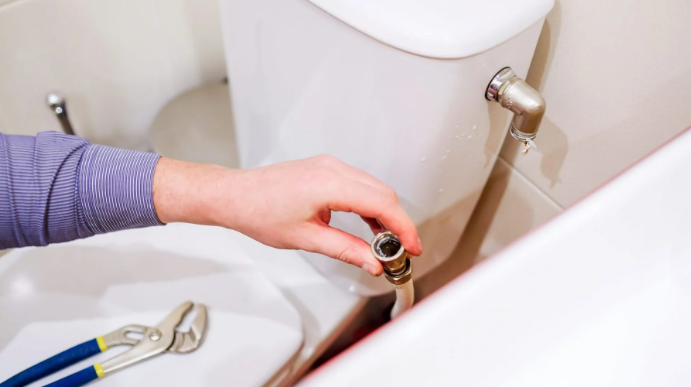A toilet leak might seem like a small thing. Maybe there’s a puddle by the base or a slow drip from the tank. Maybe the toilet runs every few hours. It’s easy to ignore, right?
Wrong.
Even a tiny leak can lead to water damage, sky-high utility bills, and expensive repairs—especially if it’s left alone. And in many homes, the toilet is used more than any other plumbing fixture. When something’s off, it matters.
Let’s break down what that toilet leak could really mean, why it happens, and what you should do about it—before it becomes a bathroom disaster.
Common Toilet Leaks and What Causes Them
Water Around the Base of the Toilet
If you see water pooling at the bottom of your toilet, it’s not from someone missing the bowl. It usually means the wax ring seal has failed.
What’s the wax ring?
It’s a round seal between the toilet and the floor drain. When it breaks, water leaks every time you flush. This water is often dirty—and can rot your floor from underneath.
Solution:
Remove the toilet, replace the wax ring, and reseat it properly. Don’t wait—this leak causes the most long-term damage if ignored.
Constant Running or “Ghost Flushing”
If your toilet seems to flush on its own—or just won’t stop running—this usually points to an issue inside the toilet tank.
Most common causes:
- Worn out flapper valve
- Misaligned or broken fill valve
- Faulty float mechanism
Even slow leaks here can waste hundreds of gallons of water a week. That’s money down the drain and added stress on your plumbing system.
Solution:
Replace the worn tank parts. These parts are cheap and widely available at any hardware store.
Dripping Between Tank and Bowl
Many toilets are made of two parts: the tank and the bowl. The bolts that connect them can wear out or loosen. When this happens, water may drip where the tank meets the bowl.
Signs:
- Dampness on the outside of the bowl
- Slow puddling after flush
- Mold or mineral buildup near connection points
Solution:
Tighten or replace the tank-to-bowl gasket and bolts. Be sure to shut off the water first!
Hidden Leaks That Cause Big Problems
Toilet Leaking Into the Floor
This one is sneaky. The leak may not show around the toilet at all—it may be leaking underneath, into the subfloor.
Signs to watch for:
- Spongy or soft flooring around the toilet
- Brown or yellow ceiling stains (in bathrooms above lower floors)
- A musty smell or mold near the toilet
What’s happening?
Water is seeping below the surface, often from a cracked flange or broken seal. Over time, this can lead to structural damage and high repair costs.
Solution:
Pull the toilet, inspect the floor and flange, and make necessary repairs before reseating the unit.
Cracked Toilet Bowl or Tank
A small crack in the porcelain may not seem like much, but it can cause a slow leak that builds up over time.
How to check:
- Look for hairline cracks near the base, tank, or bowl
- Check for dampness long after flushing
- Press gently to feel for give or weak spots
Solution:
If you find a crack, replace the toilet. Glue or epoxy is not a safe long-term fix for this.
When a Leak Is Actually Costing You More Than You Think
Water Waste and Utility Bills
According to the U.S. Environmental Protection Agency (EPA), a leaky toilet can waste up to 200 gallons of water per day. That adds up—fast.
You might not notice a jump in your water bill right away, but over time it can cost hundreds of dollars a year for just one toilet.
Fixing leaks not only saves money but helps conserve water, especially in drought-prone areas.
Mold, Mildew, and Air Quality
Leaking water = excess moisture. And where there’s moisture, mold isn’t far behind.
Mold growth behind walls or under flooring can trigger:
- Allergies
- Respiratory issues
- Musty odors
Solution:
Fix leaks early, and always dry out wet areas completely. If mold appears, professional removal may be required.
Repair or Replace? Knowing When It’s Time
Can You Fix the Leak Yourself?
Some toilet repairs are DIY-friendly:
- Replacing a flapper valve
- Tightening bolts
- Swapping out a fill valve
Just grab some tools, turn off the water, and follow online tutorials or product instructions.
When to Call in a Professional
If you see signs like:
- Warped flooring
- Major cracks in porcelain
- Repeated leaks after DIY fixes
- Leaks from hidden areas (inside walls or below floors)
…it’s time to call a licensed plumber. They can diagnose deeper issues like sewer line cracks or venting problems that aren’t visible from above.
Upgrading Might Be Smarter Than Repairing
Older toilets (especially those from before 1994) can use 3–5 gallons per flush. New high-efficiency models use just 1.28 gallons and flush better.
So, if your toilet:
- Needs frequent repairs
- Has visible damage
- Is wasting water every day
…it may be cheaper in the long run to replace it with a new, efficient model.
Conclusion: Don’t Wait for the Water to Win
A leaky toilet isn’t just annoying—it’s a sign that something’s wrong. And whether it’s a loose bolt, a broken seal, or a hidden crack, ignoring it can lead to major damage and bigger costs.
Start with a simple check. Look around the base. Listen for hissing or dripping sounds. Take the tank lid off and see if parts are loose or worn.
Fixing a leak now is way cheaper than repairing your subfloor later. And let’s be real—nobody wants to deal with mold, water damage, or emergency calls in the middle of the night.
If your toilet is leaking, don’t wait. Whether it’s a quick fix or a sign you need a full upgrade, now’s the time to take care of it.


